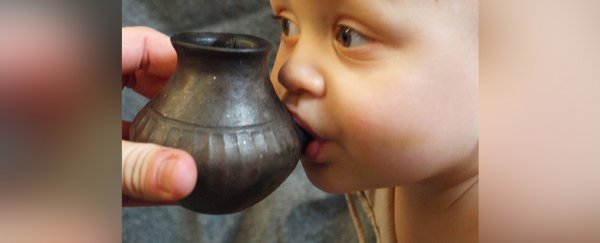Some 2,500 years ago, in what is today southern Germany, a small child's body was laid to rest. A bronze bracelet adorned their wrist and a tiny ceramic jug was placed at their feet.
We can easily imagine them sipping from the child-sized cup, but exactly what it held has never been certain. Now, an analysis of the residue inside this and similar containers finally provides solid evidence of a toddler's dairy diet thousands of years in the past.
Small vessels with nipple-like spouts, like these below, have been found alongside the remains of young children in graves all across Europe. Dating as far back as 5,500 BCE, they become increasingly common from the late Bronze Age into the early Iron Age.
 (Katharina Rebay-Salisbury)
(Katharina Rebay-Salisbury)
The shapes and locations of the objects have strongly suggested that what we have here are ancient sippy-cups. And what else would you put into a baby's drinking vessel than fresh milk?
To get hard evidence describing what was stored in these ceramic vessels, British and German researchers ran a series of chemical tests on the thin film of material stuck to the inside wall of two small vessels found in a cemetery in the lower Altmühl valley in Bavaria.
Both were around 50 millimetres (around 2 inches) across, and intact. Unlike most other containers, these had wide openings that made it easier to scrape out their contents. A third, broken vessel found among the cremated remains of a toddler was also studied.
The preserved organic matter researchers found was made up of large amounts of animal fats, of the type you'd find in ancient traces of milk.
Some shorter chains of fatty acids were also spotted. These aren't exactly common in ancient pottery, and appear to be signs that the milk being consumed was probably fresh rather than processed.
Further analysis of the contents suggests one of the two intact containers and the broken cup once stored milk from a ruminant, such as a cow or a goat. The other container contained a mix, possibly sourced from a pig or a human.
"The finding of these three obviously specialised vessels in child graves combined with our chemical evidence strongly points to these vessels having been used to feed animal milk to babies (instead of human milk) and/or children during weaning to supplementary foods," the researchers conclude.
To what extent these materials would have supplemented human breast milk isn't at all clear, though they're unlikely to have been their only source of nutrition. Non-human milk lacks qualities that help children develop, while also containing fats that make it harder to absorb nutrients. There's also the problem of a small but increased risk of contamination by pathogens.
Animal-shaped pottery from Neolithic sites around the Mediterranean has previously been found to contain traces of dairy products, indicating that the practice of giving milk to children – who are less likely to have an intolerance to it – could have been widespread.
For all the risks, there must have been advantages in giving the children of these periods a little extra in the form of animal milk, whether to add nutrition in lean times, or for cultural reasons.
As our ancestors settled into agrarian lifestyles, there were shorter periods between births, suggesting milk from livestock might have helped out with early weaning.
Dairy has become such a significant part of the human diet across the west, we've evolved to deal with its tummy-upsetting effects.
Exactly why we made use of this resource in the first place is still a mystery, but the way we once weaned our children could help us make sense of the cultural side of the transition.
This research was published in Nature.
